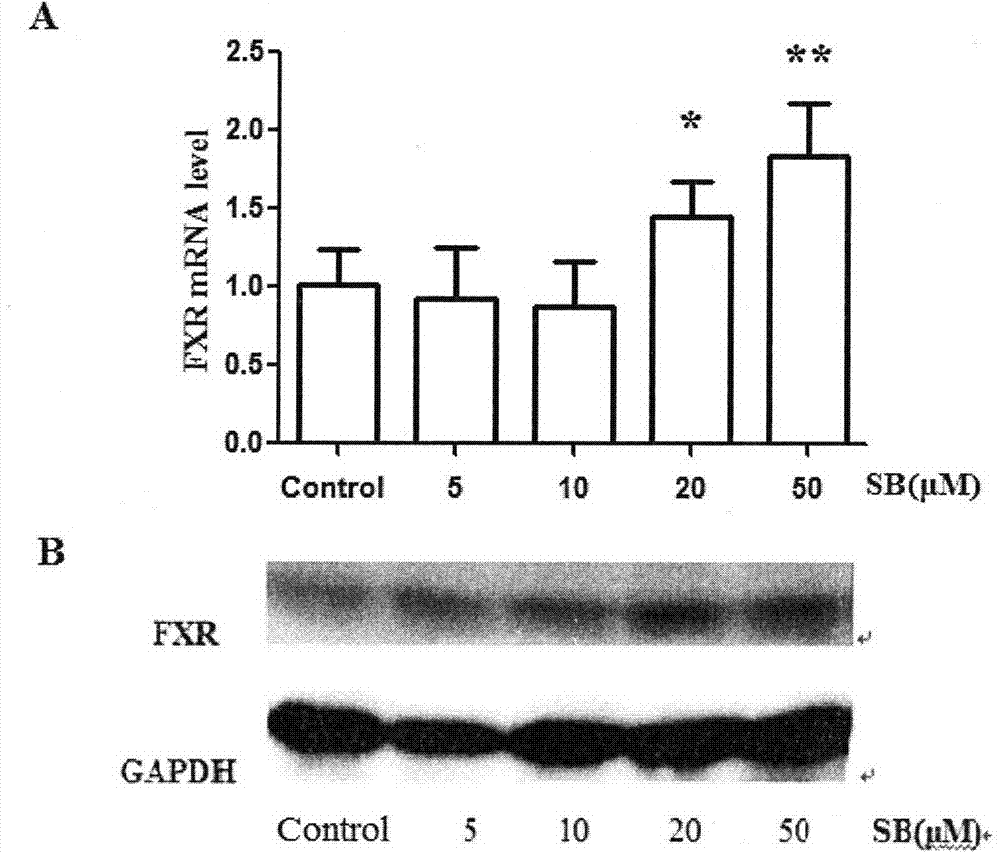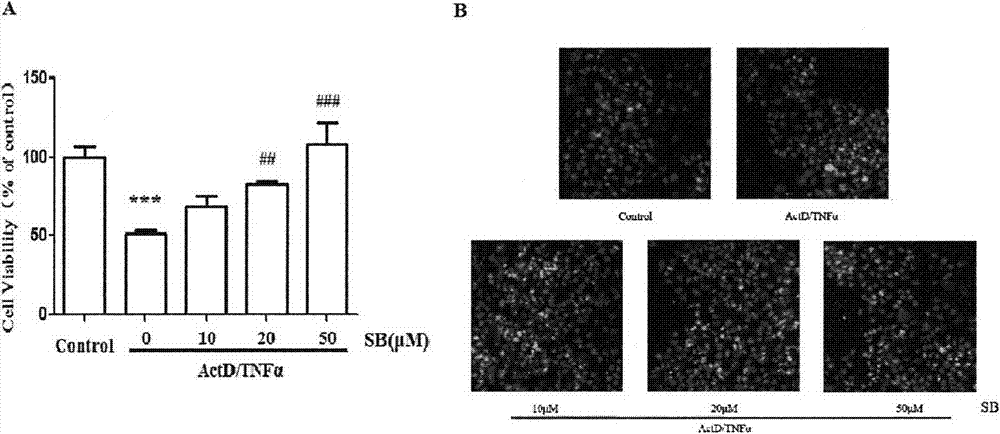Action mechanism of silybin for preventing liver apoptosis through FXR (Farnesoid X Receptor) path
A technology of silibinin and its mechanism of action, applied in the research progress field of silibinin exerting anti-hepatocyte apoptosis via FXR-dependent pathway
- Summary
- Abstract
- Description
- Claims
- Application Information
AI Technical Summary
Problems solved by technology
Method used
Image
Examples
Embodiment 1
[0011] Embodiment 1.PCR experiment
[0012] Experimental Materials:
[0013] Human liver cancer cell line HepG2 cells were purchased from Shanghai Cell Bank and stored at 37°C in 5% CO 2 Under normal conditions, the culture medium was DMEM (Gibco) containing 10% calf serum; fetal bovine serum (Fetal bovine serum) was purchased from Hyclone (Logan, Utah, USA); trypsin (Trypsin) was purchased from Amersco (Solon, Ohio, USA); penicillin, streptomycin and dimethylthiodiphenyl tetrathiazole (MTT) were all purchased from Nanjing Shengxing Bioengineering Company (Jiangsu); FXR primers and internal reference GAPDH primers, Control SiRNA and FXR SiRNA, RNAiMAX transfection reagents were purchased from Invitrogen; Trizol Total RNA Extraction Reagent, RT-PCR Kit, Real-time PCR Master Mix (SYBR Green) were purchased from Takara (Dalian Bao Biology); FXR antibody was purchased from Santa Cruz Company, GAPDH antibody Purchased from Bioworld; RIPA cell lysate, Hoechst33342 staining solutio...
Embodiment 2
[0020] Embodiment 2.Western Blot experiment
[0021] Experimental material: with embodiment 1.
[0022] experimental method:
[0023] After HepG2 cells were seeded in six-well plates for 48 hours, they were stimulated with 0, 5, 10, 20, and 50 μM silibinin for 24 hours, respectively. In addition, HepG2 cells were stimulated with ActD (0.2 μM) and TNFα (20 ng / ml) 48 hours after seeding in six-well plates, and stimulated with different doses of silibinin (0, 10, 20 and 50 μM) for 12 hours. After washing the cells once with PBS, place them on an ice plate, scrape the cells with a cell scraper, and centrifuge at 8000rpm×1min to obtain the cell pellet. Add 100μL RIPA cell lysate to each 20μL cell volume, lyse on ice for 30min, and ultrasonicate Broken 5 times, 2s each time, centrifuged at 15000rpm×10min to obtain the supernatant which is the extracted total protein sample. Protein concentration was determined by BCA method. Protein samples were added to loading buffer at a volu...
Embodiment 3
[0024] Embodiment 3.MTT experiment
[0025] Experimental material: with embodiment 1.
[0026] experimental method:
[0027] 1.MTT experiment
[0028] HepG2 cells were seeded in 96-well plates, stimulated with ActD (0.2μM) and TNFα (20ng / ml) after 48h, and given different doses of silibinin (0, 10, 20 and 50μM). After 12 hours, add 20 μL (5 mg / mL) MTT to each well, incubate in a carbon dioxide incubator for 4 hours, remove the MTT solution, add DMSO (150 μL / well) to dissolve the crystals (37°C shaker, 50 r / min), and take it out after 30 minutes. The absorbance was measured in a microplate reader (measurement wavelength 490nm, reference wavelength 630nm). The cell survival rate of the administration group was calculated by the following formula:
[0029] Survival rate = absorbance of treatment group / absorbance of control group * 100%
[0030] 2. FXR gene silencing
[0031] According to the instruction manual of RNAiMAX transfection reagent (Invitrogen), add the reagent ...
PUM
 Login to View More
Login to View More Abstract
Description
Claims
Application Information
 Login to View More
Login to View More - R&D Engineer
- R&D Manager
- IP Professional
- Industry Leading Data Capabilities
- Powerful AI technology
- Patent DNA Extraction
Browse by: Latest US Patents, China's latest patents, Technical Efficacy Thesaurus, Application Domain, Technology Topic, Popular Technical Reports.
© 2024 PatSnap. All rights reserved.Legal|Privacy policy|Modern Slavery Act Transparency Statement|Sitemap|About US| Contact US: help@patsnap.com










